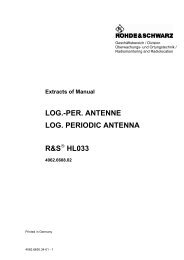Glossary of Video Terms and Acronyms - Isotest
Glossary of Video Terms and Acronyms - Isotest
Glossary of Video Terms and Acronyms - Isotest
Create successful ePaper yourself
Turn your PDF publications into a flip-book with our unique Google optimized e-Paper software.
<strong>Video</strong> <strong>Terms</strong> <strong>and</strong> <strong>Acronyms</strong><br />
<strong>Glossary</strong><br />
constrained by the practical filters, sensors, phosphors, etc. employed in<br />
order to achieve conformance to the defined primary colors <strong>of</strong> the specified<br />
system. Similar matrix transformations compensate for the viewing conditions<br />
such as a white point <strong>of</strong> the display different from the white point <strong>of</strong><br />
the original scene. d) Choosing <strong>and</strong> defining primary colors requires a balance<br />
between a wide color gamut reproducing the largest number <strong>of</strong><br />
observable surface colors <strong>and</strong> the signal-to-noise penalties <strong>of</strong> colorimetric<br />
transformations requiring larger matrix coefficients as the color gamut is<br />
extended. e) There is no technical requirement that primary colors should<br />
be chosen identical with filter or phosphor dominant wavelengths. The<br />
matrix coefficients, however, increase in magnitude as the available display<br />
primaries occupy a smaller <strong>and</strong> smaller portion <strong>of</strong> the color gamut. (Thus,<br />
spectral color primaries, desirable for improved colorimetry, become<br />
impractical for CRT displays.) f) Although a number <strong>of</strong> primary color sets<br />
are theoretically interesting, CCIR, with international consensus, has established<br />
the current technology <strong>and</strong> practice internationally that is based<br />
(within measurement tolerances) upon the following: Red – x = 0.640, y =<br />
0.330; Green – x = 0.300, y = 0.600; Blue – x = 0.150, y = 0.060.<br />
g) SMPTE <strong>of</strong>fers guidance for further studies in improving color rendition<br />
by extending the color gamut. With regard to color gamut, it is felt that the<br />
system should embrace a gamut at least as large as that represented by<br />
the following primaries: Red – x = 0.670, y = 0.330; Green – x = 0.210,<br />
y = 0.710; Blue – x = 0.150, y = 0.060.<br />
Color, Subjective – Subtractive colorimetry achieves metameric matching<br />
by removing portions <strong>of</strong> the spectrum from white light. The subtractive<br />
counterparts to the additive color primaries are those which when removed<br />
from white leave the red, green, <strong>and</strong> blue accordingly cyan, magenta, <strong>and</strong><br />
yellow. Combinations <strong>of</strong> these subtractive colors in various add mixtures<br />
provide metameric matches to many colors. Subtractive color principles are<br />
employed in all hard-copy color images <strong>and</strong> in light-valve systems such as<br />
color transparencies, LCD panel display, motion-picture films, etc.<br />
Colorimetry – a) Characteristics <strong>of</strong> color reproduction including the range<br />
<strong>of</strong> colors that a television system can reproduce. Some ATV schemes call<br />
for substantially different colorimetry (with a greater range) than NTSC’s.<br />
b) The techniques for the measurement <strong>of</strong> color <strong>and</strong> for the interpretation<br />
<strong>of</strong> the results <strong>of</strong> such computations. Note: The measurement <strong>of</strong> color is<br />
made possible by the properties <strong>of</strong> the eye, <strong>and</strong> is based upon a set <strong>of</strong><br />
conventions.<br />
Colorization – Special effect (also called paint) which colors a monochrome<br />
or color image with artificial colors. This feature is found on both<br />
the Digital <strong>Video</strong> Mixer <strong>and</strong> <strong>Video</strong> Equalizer.<br />
Color-Matching Functions – a) The tristimulus values <strong>of</strong> monochromatic<br />
stimuli <strong>of</strong> equal radiant power. The three values <strong>of</strong> a set <strong>of</strong> color-matching<br />
functions at a given wavelength are called color-coefficients. The colormatching<br />
functions may be used to calculate the tristimulus values <strong>of</strong> a<br />
color stimulus from the color stimulus function. b) The tristimulus value per<br />
unit wavelength interval <strong>and</strong> unit spectral radiant flux. c) A set <strong>of</strong> three<br />
simultaneous equations used to transform a color specification from one<br />
set <strong>of</strong> matching stimuli to another. Note: Color-matching functions adopted<br />
by the CIE are tabulated as functions <strong>of</strong> wavelength throughout the spectrum<br />
<strong>and</strong> are given in Section 13.5 <strong>of</strong> ANSI/IES RP16-1986.<br />
36 www.tektronix.com/video_audio<br />
Comb Filter – A filter that can be used to separate luminance from<br />
chrominance in the NTSC or PAL composite video systems. The figure<br />
below shows a signal amplitude over frequency representation <strong>of</strong> the luminance<br />
<strong>and</strong> chrominance information that makes up the composite video<br />
signal. The peaks in gray are the chroma information at the color carrier<br />
frequency. Note how the chroma information falls between the luminance<br />
information that is in white. The comb filter is able to pass just energy<br />
found in the chroma frequency areas <strong>and</strong> not the luminance energy. This<br />
selective b<strong>and</strong>pass pr<strong>of</strong>ile looks like the teeth <strong>of</strong> a comb <strong>and</strong> thus the<br />
name comb filter. The comb filter has superior filtering capability when<br />
compared to the chroma trap because the chroma trap acts more like a<br />
notch filter.<br />
Frequencies the Comb Filter<br />
passes as chrominance information.<br />
Combination Tone – A tone perceived by the ear which is equal in frequency<br />
to the sum or difference <strong>of</strong> the frequencies <strong>of</strong> two loud tones that<br />
differ by more than 50 Hz.<br />
Combinational Logic – Circuit arrangement in which the output state is<br />
determined only by the present states <strong>of</strong> two or more inputs. Also called<br />
Combinatorial Logic.<br />
Combiner – In digital picture manipulators, a device that controls the way<br />
in which two or more channels work together. Under s<strong>of</strong>tware control, it<br />
determines the priority <strong>of</strong> channels (which picture appears in front <strong>and</strong><br />
which in back) <strong>and</strong> the types <strong>of</strong> transitions that can take place between<br />
them.<br />
Combo Box – In Micros<strong>of</strong>t Windows, a combination <strong>of</strong> a text <strong>and</strong> a list<br />
box. You can either type the desired value or select it from the list.<br />
Comm<strong>and</strong> Buttons – In Micros<strong>of</strong>t Windows, “button-shaped” symbols<br />
that are “pressed” (“clicked on”/chosen) to perform the indicated action.<br />
Comment Field – Field within an instruction that is reserved for comments.<br />
Ignored by the compiler or the assembler when the program is converted<br />
to machine code.<br />
Common Carrier – Telecommunication company that provides communications<br />
transmission services to the public.<br />
Common Data Rate (CDR) – In the search for a single worldwide st<strong>and</strong>ard<br />
for HDTV, one proposal is to establish a common data rate, to be<br />
independent <strong>of</strong> line structure, frame rate, <strong>and</strong> sync/blanking.





